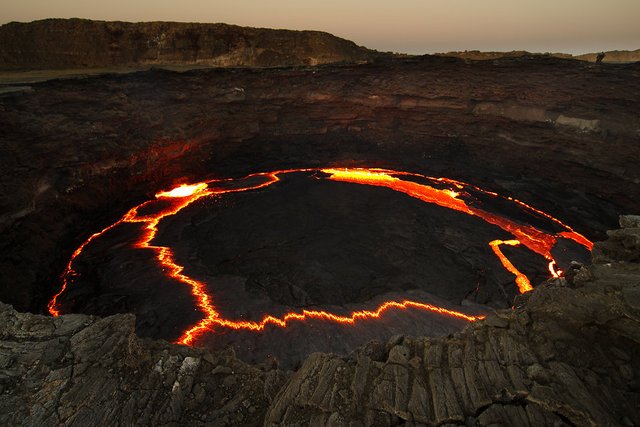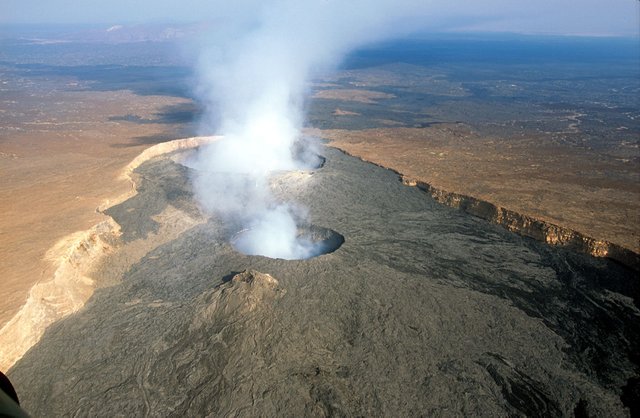Wonders of nature. Erta Ale

The curved chain of volcanoes rises from the depression of Danakil - "the land of horror, hardship, death"
British researcher Ludovic Nesbitt wrote in 1934: "Maybe our grandchildren will travel to the stars, and then our painful attempts to pass through the unknown corners of the earth will cause them a smile."
The car and the airplane, he thought, are too alien to the outside world and can not merge with it. He was happy to "use the ancient, slow ways of research, in which the taste and smell of new lands are overthrown by the traveler." Such were the methods of his expedition in 1928, when he, accompanied by two Italians, became the first of Europeans to see a majestic group of volcanoes, called Erta Ale.
The purpose of the trip was to pass 640 kilometers from south to north through the depression of Danakil, part of the East African rift system. The outlook was not very encouraging. Most of the way ran through the alkaline desert, which sank far below sea level, where the air is heated, like in a stove. There was practically no water, and the Apheresis were considered cruel and bloodthirsty. Approximately half a dozen expeditions of Europeans trying to pass through this area during the previous 50 years have disappeared.

From the Aussa Oasis on the Awash River, Nesbitt's route passed through the desert. Day after day the sun was getting hotter, and the expedition began to move at night and at dawn. When the sun rose, the sky and the desert merged, forming a single whole, without a horizon line, without landmarks and distances. The heat of the sun was hot. But this did not go to any comparison with the hell of the Danakil hollow. There, it seemed, the earth itself was burning. There was no water, and even the camels began to perish. In the sun, the air temperature rises to 75°C. To save themselves from the heat, people and beasts of burden climbed under the rocks like insects. All the time in the distance, they saw the white figures of the Afar warriors wrapped in white. For them, the expedition, especially the rifles, represented untold riches.
One evening, when the haze began to dissipate, a stunning sight unexpectedly opened. Five huge volcanoes lined up from the whitish plain were right in front of them along the arc. The conductor whispered their name: Erta Ale - Burning mountains. Closer than all was Ummune with a dense cloud of smoke on the side. Behind him stood the strikingly symmetrical Erta Ale. Above all the mountains hung a huge veil of smoke, which in the twilight shone with a pulsating reddish glow.
The next morning, the researchers set out to come closer. However, the land on the way to the volcanoes was not at all as level as it looked from afar. It represented a wavy surface of lava, reminiscent of a frozen sea, and each wave had a razor sharp as a razor. The cavities between them were filled with volcanic slag, which crunched underfoot like glass, cut off shoes and skin. So without reaching the goal, wounded travelers headed west, past the muzzle of Alu Mountain, and climbed up the steep slope. Before them, they saw a sparkling plain of rock salt.

The undying fire behind and the terrible plain ahead of Nesbitt christened the Earth of horror. Having exhausted all their strength, they reached the water, but it turned out that the natives blocked the way to it. To the delight of the researchers, they were not warriors, but salt miners, who cordially greeted them and helped break up the camp near such a coveted water. A few days later the expedition began the last stage of the journey to the north, to the Red Sea. In total, including the way through the most terrible land in the world, they walked three and a half months.
She stands by her salt
The depression of Danakil is one of the harshest places on our planet. For most of the year this is a dry, salt-covered plain. Its main territory is located below sea level, once it was part of the Red Sea - until the earth's crust movements erected the Danakil Range to the north, cutting off this area from the sea. The water evaporated, leaving behind him on the former seabed a layer of salt up to 3 kilometers thick. From time to time rains wash the salt from the areas above, to the lowest point, Lake Karum. This shallow lake, filled with saturated brine, lies 120 meters below sea level. Every year for a short period, it spills 72 kilometers across, and around it are hot springs from the water that seeps through the rocks and meets there with molten magma rising from the center of the Earth.
Wandering in Hell
In the Danakil Basin there live nomadic tribes - Afarans, or Danakilians, as they are called by other peoples of this region. They survive in such a hell, thanks to nomadic cattle breeding and salt extraction.
For many centuries the salt from Lake Karum provides the life of local tribes, which with the help of sticks raise blocks of salt from salt deposits and give them the shape of bricks. Then the salt is exported to North and East Africa. Many Afarans, however, still continue the cattle-breeding traditions of their ancestors, wandering from place to place with the herds of goats, sheep and camels. The Afarans have a very attractive appearance - they are tall, lean and muscular. Women gracefully wear long brown skirts, and men - white cotton loincloths and wrapped in white cloth. The food of the Apharis consists mainly of milk and meat, so prolonged droughts carry hunger and death to both animals and humans.